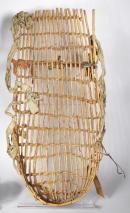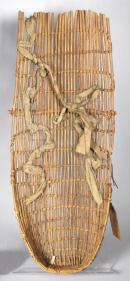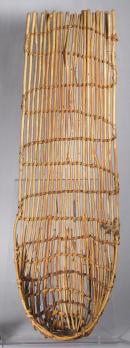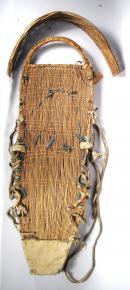The Great Basin stretches across portions of Idaho, Montana, California, Nevada, and Wyoming. The MPM collection contains items from the Washoe (1), Paiute (1), as well as the Northern Paiute of Pyramid Lake (4) and Walker River (2) Reservations. Cradles of the Great Basin were either basket-like, woven of woody shoot materials like willow or sumac, or they were the “inverted U” shaped cradles influenced by those of the northwestern Plains. The cradles in MPM’s collection are of the first variety. Newborns were placed in woven oval receiving baskets or temporary openwork cradles, and were given more personalized cradles after a few weeks. These cradles were trapezoidal in shape, with rods hitched vertically with plant fiber, and stout willow sticks hitched horizontally across the cradle back, to which a tumpline was attached. Children were swaddled with cloth and then laced to the cradle. A piece of cloth or hide was sewn to the bottom of the frame to protect it from the damage incurred when the cradle was set upright. More elaborate forms of this woven cradle were similar to Plains “inverted-U” cradles, which included a woven hood and a hide covering that was wrapped around the wooden frame, into which the child was laced. The woven hood was often decorated with line designs depending on the child’s gender. Boys received diagonal lines, girls received diamonds. Neutral designs were used if the gender was not known, or if the family planned for several children to use the cradle.








